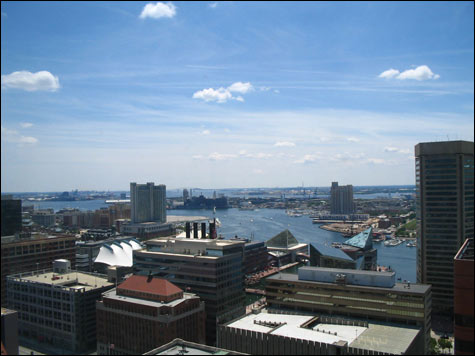
SISTER CITY? A view of Baltimore Harbor. |
This is not the only area in which Maryland and the Biggest Little are seeking synergy. Herb Weiss, from the City of Pawtucket's economic development office, recently alerted me to a study done by the Department of Urban Studies and Planning at the University of Maryland that looked at lessons Baltimore might learn from cities that have turned the arts into an economic development engine. A group of students in a master's program studio under the tutelage of Professor Sidney Brower studied Providence and Pawtucket as well as Pittsburgh, Pennsylvania and Worcester, Massachusetts.
Since the early 1970s, when I first became aware of the underground arts scene in Baltimore (thanks to my friends Mark Kehoe and David Byrne), I have found Charm City and the Biggest Little to share a fascinating symbiosis. At that time, John Waters and his "Dreamlanders" posse (Divine, Mary Vivian "Mink Stole" Pearce, Edith Massey, Vincent Peranio, Van Smith, et al) were the dominant and defining figures in Baltimore while, here in La Prov, it was the Fabulous Motels and our posse (Charles Rocket, Bonita Flanders, Simone Cuc, Dan Gosch, Jeff Thomas, et al) who were forging a brave new art vision that was goofy, silly, and generally X-rated. In short, somewhat like real life — or at least the "real life" we were living. I continue to find strong parallels in our respective cultures, but I'll discuss that at some other time. For now, back to the report.
What I took from reading parts of the document, "Arts Impact: Examining the Establishment of an Arts District on Baltimore's West Side," was that the experiences in art and economic development in Pawtucket seemed to be the most impressive — the model that the Baltimoreans are most interested in emulating. Pawtucket artists told the Baltimoreans that affordable work-live spaces are vital. Another urgent need, the artists explained, is a "consistent way to sell and display" work.
And, of course, the Pawtucket artists had lots of thoughtful and cool ideas. One of them described how "in the Penlands community of North Carolina . . . glassblowers have their studios in the basement so that the heat from their equipment can heat the entire building." The cleverness here is further support for a long-held proposition of mine: Let the artists run the world. They are the smartest (and truly, the holiest) people of our communities.
Some other valuable ideas from the U. of Maryland study: "Provide ways for artists to share large equipment such as hydraulic lifts, trucks and vans, etc., that they only need occasionally, so each studio doesn't have to purchase it." And, "establish a formal apprenticeship program that would allow young artists to attach themselves to a studio, learn the skills, work with the master artists on an ongoing basis and then become journeymen and women before striking out on their own."
The report also cites Pawtucket for its Riverfront Lofts development (kudos to Morris and Phyllis Nathanson) — the "most successful-looking of the mill revitalization projects" and the city's true "secret weapon" — and the aforementioned Herb Weiss, described in the report as "a dedicated person within city government to act as an advocate for artists" and described by "everyone we spoke with in both Pawtucket and Providence as an indispensable go-to person when an artist needs help with anything."